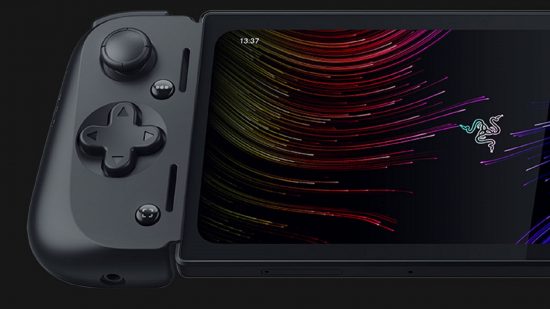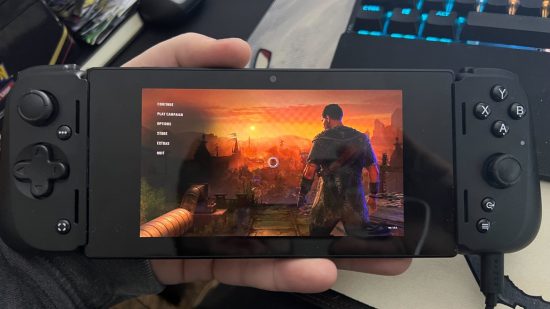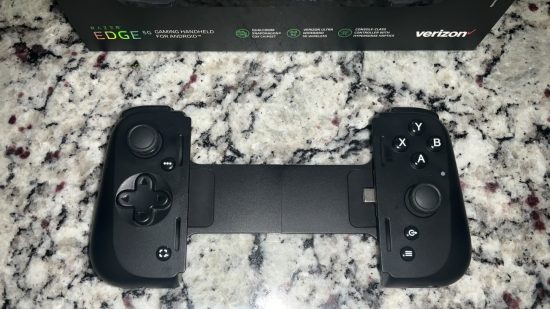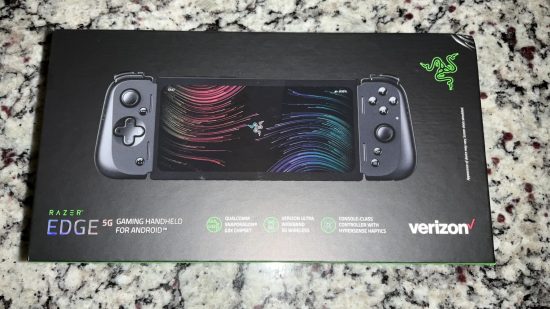With cloud gaming becoming a major industry focus, the race is on to create the perfect cloud gaming device for gamers on the go to keep up with their favourite titles. You can temporarily convert some existing tech – like your phone – into a gaming handheld, but a leader in specific gaming-focused hardware has yet to find footing.
Razer is trying to change this with the Razer Edge 5G, a cellular network-activated, hyper-powerful tablet built on Android technology that’s made for gaming on the cloud. For the most part, the Edge gets the job done; where the problem lies in how it differentiates itself from other devices. To be frank, it doesn’t.
The Razer Edge 5G is an Android tablet featuring a Qualcomm Snapdragon G3X chipset, Verizon ultra wideband 5G wireless, and a 6.8-inch, 144hz AMOLED touchscreen. For those that don’t speak technology, it’s essentially a souped-up Android tablet made with cloud gaming in mind. That extra power does wonders too, as playing games on this thing is silky smooth.
To get a wide swath of what this device is capable of, I tried multiple different cloud gaming apps: Xbox Cloud Gaming, Nvidia GeForce Now, PS5 Remote Play, and a few native mobile apps via the Google Play store. I’m happy to report that every single one of these handles beautifully on the Razer Edge 5G, showing off the device’s incredible power.
Each one of these examples feels like playing on the actual hardware instead of on a cloud device. Controls are responsive with little to no input delays, and the frame rate rarely struggles whether I’m using a local wi-fi connection or out and about using the cellular 5G capabilities. Xbox Cloud Gaming, specifically, works incredibly well on the Razer Edge, and I tried both single-player games like Hi-Fi Rush and Disney Dreamlight Valley, as well as online multiplayer titles like Fortnite and Halo.
The OLED screen is particularly impressive, as every game pops off the screen with colour and detail. I’m always amazed at how vibrant even dark and moody games like Dying Light 2 look on this screen, and it’s sometimes difficult wrapping my head around a cloud-streaming experience looking as good as it does. The touchscreen is quick and responsive as well, though admittedly I spent more time looking at the screen than I did touching it thanks to the included controller case.
Despite how impressive the Razer Edge 5G is, there’s one point I mentioned before that I cannot stress enough: this is an Android tablet with some extra power under the hood… and that’s it. This means that if you already own an Android tablet – or if you’re an iPhone or iPad user – you can do everything this tablet can do within a reasonable degree.
I compared the performance of my iPhone 13 Pro and iPad Mini 6 with the Edge, and both devices perform admirably next to this gaming-focused device. I used my iPhone with Disney Dreamlight Valley specifically, not only playing it on the phone but also mirroring the phone to my living room television, and the game performs just as well there as it does with the Edge. The graphical fidelity may suffer a bit, but that was the only hiccup; otherwise, this is a smooth and easy experience.
Through that lens, the appeal of the Razer Edge 5G starts to lose its lustre. The device had an opportunity to stand out from the pack and cement itself as the leading cloud gaming device on the market, but instead, it’s the equivalent of a custom built PC versus a pre-built one from a store. You might not get the same top-of-the-line, 100% perfect experience on tech you already own as what the Razer Edge offers, but if you don’t require a spotless, perfect gaming experience on the go, if you just want to load up a game and enjoy it for a bit, then the Razer Edge 5G starts to seem extraneous instead of essential.
That said, one major perk in the Edge’s corner is the inclusion of the aforementioned controller case, the Razer Kishi V2, which the device slips right into without issue. The inclusion of the Kishi is super smart, as it makes playing games much easier than if I were left with just the touchscreen. Not that the touchscreen is impossible to use – it served me well in the PS5 Remote Play app, which wouldn’t recognize the Kishi for some reason – but the controller casing of the Kishi gives the entire device a Nintendo Switch-style feel that feels natural and comfortable in my hands. That comfort, coupled with the fact that you can charge the Edge while remaining in the Kishi, makes the extra add-on a super convenient and much-appreciated addition.
I also appreciate the device’s unique app, Razer Nexus, which aggregates all of the gaming apps into one easy-to-access place. It’s simple to navigate, allowing me to choose which program or game I want to play and booting it up without any issues. It also lets me record my gameplay directly to the device at the push of a single button, which is a convenient option for whenever I have to capture gameplay. I like having every program in one place, and I especially liked the console-esque one-press capture functionality.
The Razer Edge 5G holds a lot of power in its small frame, with its ability to stream cloud gaming with near-perfect results apparent as soon as I opened the box. Each game plays wonderfully and looks beautiful, with very few hiccups experienced throughout my time with the device. However, I cannot call the Edge 5G an “essential” purchase, as it doesn’t do enough to completely separate it from other mobile devices on the market. It’s a luxury item of sorts; something for those who don’t want to game on cell phones to pick up for dedicated mobile gaming. For the layman, however, this Razer device doesn’t do enough to give it an Edge.
For more content like this, we recommend you take a look at our list of the best portable gaming consoles and best gaming phones.
Razer Edge 5G review
While the Razer Edge 5G provides an incredible gaming experience on the go, with access to multiple cloud-based apps and the hundreds of games within, there’s very little this device can do that your existing phone or tablet cannot also do to achieve similar, if not exactly the same, results.















